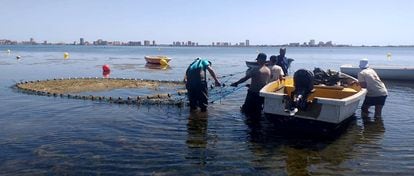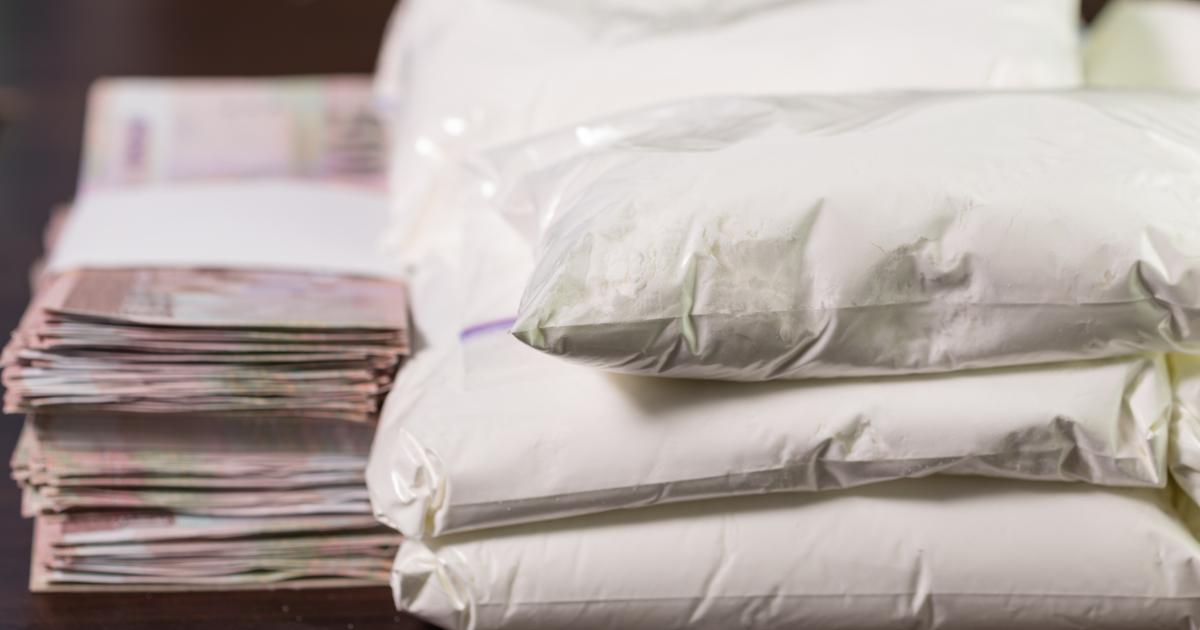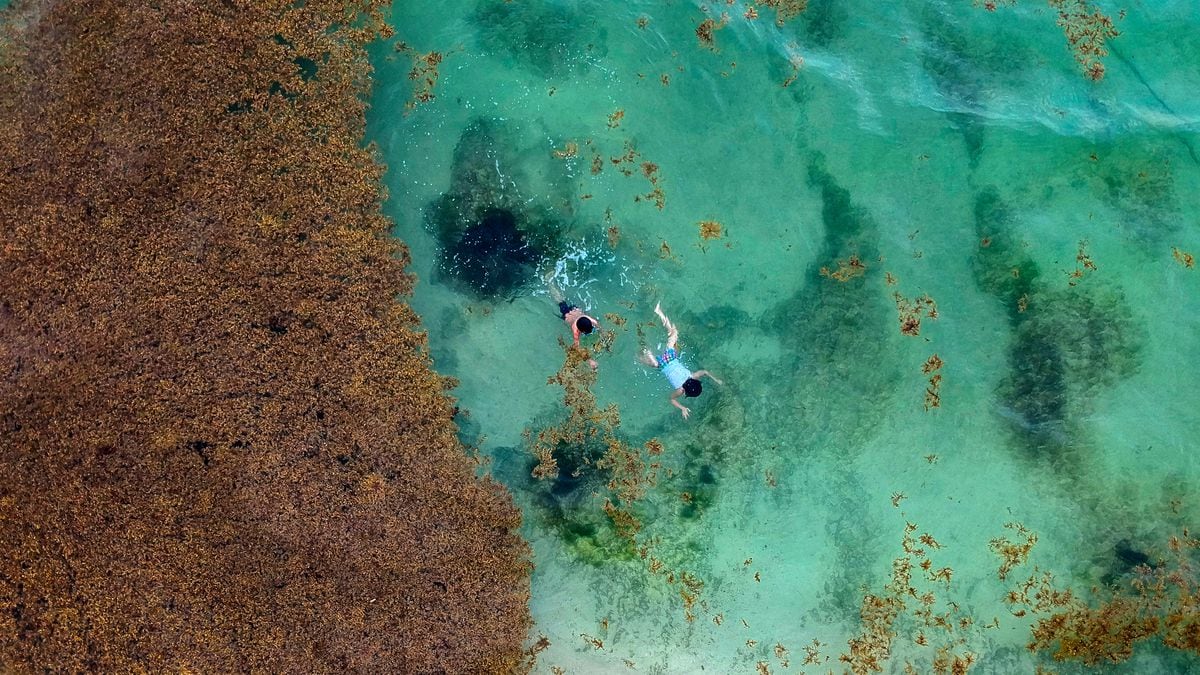The image is explicit, several workers remove by hand from the shores of the Mar Menor, in Murcia, a kind of rolled up carpet of algae that seems to have no end to put it on a boat.
From there, the greenish mass is transferred to some containers.
Day after day, 100 workers in the shallower area of the lagoon and 50 fishermen inside it collect the algae at a rate of about 100 tons per day since April, when the last episode of lack of oxygen occurred due to the excessive growth of these plants.
Until May 25, they had removed 5,900 tons, a figure that is updated every 15 days.
The device to clean the lagoon of algae has been put into operation every year since 2017, when the waters first collapsed and turned into a cloudy greenish liquid.
In the five previous campaigns,
the operators extracted a total of 8,400 tons, at an average of 1,680 per year.
The current figure triples that amount.
In April, an exaggerated proliferation of algae known as angel hair (
Chaetomorpha linum
) was detected, which has caused a lack of oxygen in an area of Las Lomas (municipality of Cartagena), which continues with levels of hypoxia.
There was another area in front of the Ciudad del Aire (municipality of San Javier) in which the cause of the mortality of some fish is being investigated;
this second episode is already solved.
The plant appears when there is excess nitrogen in the water, which in the Mar Menor comes mainly from the fertilizers used in the agricultural area of Campo de Cartagena - known as the garden of Europe - and which end up reaching the lagoon, especially by the Rambla del Albujón, in which the aquifer that extends below discharges, and by runoff with the rains.
It is as if the Mar Menor was fertilized, facilitating the appearance of algae.
At this time, the concentration of nitrates in the aquifer is "very high, 200 milligrams per liter, when European directives only allow 50 milligrams per liter," says Emilio María Dolores, head of the Fisheries and Aquaculture service of the Community of Murcia and spokesperson for the scientific committee of the Mar Menor, made up of politicians and experts.
The significant rainfall in March and April has complicated the situation, as more water arrived from land loaded with nitrates.
This increase can be seen in the Rambla del Albujón through which 6.3 cubic hectometres have flowed into the lagoon so far this year, when in all of 2021 they were 4.5 cubic hectometres.
“With this volume, we estimate that 740 tons of nitrates entered last year and so far in 2022 we have already exceeded 820 tons,” María Dolores specifies.
More information
The Mar Menor throws dead fish again due to lack of oxygen in the water
And that is the reason for the recent explosion of
chaetomorpha linum-
type algae , "which is filamentous and has the advantage of absorbing excess nitrogen and, due to its high photosynthetic activity, maintaining high oxygen levels," he indicates.
But, next line, the drawbacks appear: "When it dies, it decomposes and falls to the ground, where it rots, and that inorganic matter is incorporated into the sediment or the water column and causes oxygen levels to drop."
María Dolores explains that, as the days go by, “the scenario will probably change with a greater proliferation of phytoplankton (composed of microscopic organisms), which will increase the turbidity of the water and will prevent the sun from penetrating to the bottom, so that the algae who live there die by not being able to carry out photosynthesis, contributing to the putrefaction of the waters, which happened in the first crisis in August 2016″.
The only immediate solution to avoid a similar scenario in an ecosystem as damaged as the Mar Menor is to remove excess algae.
The Segura Hydrographic Confederation, for its part, has restarted pumping from the Rambla del Albujón through a collector to a channel from where it is reused by the agricultural sector.
“This causes the flow to drop.
If a few weeks ago between 400 and 500 liters per second entered the Mar Menor through the Albujón, now it is just over 200″, maintains the spokesman for the scientific committee.
There is a lack of measures at source that reduce the level of fertilizers used in the fields, says Ramón Pagán, spokesman for the citizen platform Pact for the Mar Menor.
“There have always been thread algae that float in the water.
Although never with this dimension”, he maintains.
He considers that the actions that are currently being carried out are palliative and that until "an exhaustive control of the amount of nutrients that farmers use in their crops is not carried out, nothing will be fixed."
The Murcian Executive responds that they are already taking measures at source with the limitation of crops to less than 1,500 meters from the Mar Menor, reduction of mineral fertilizers and prohibition of fertilizers that contain inorganic and synthetic nitrogen.
Collection of algae in the Mar Menor. GOVERNMENT OF MURCIA
less and less fishing
The chief patron of the San Pedro del Pinatar fishermen's association, José Blaya, explains the bad times they are going through: "Now is the time for shrimp, unique for the flavor that the salinity of the lagoon gives it, and we are fishing 60% less than other seasons, because the nets get very dirty and the poor state of the water affects their reproduction”.
The algae also cover the ground and the shrimp is fished in sand, so it is impossible to find it in certain areas.
Given this scenario, the Murcia Government contracting 25 boats with 50 fishermen to remove the algae "is a great help, because there is very little fishing, not only is it shrimp, it also affects other catches such as sea bream or sea bass ”, he clarifies.
They catch the algae by hand, with nets, rakes and a kind of pitchfork.
Blaya maintains that they see improvement after more than two months cleaning, but is also aware that the situation can "get worse at any time."
“We are in a critical situation and we don't know what will happen to our work.
The Mar Menor has become a bomb field”, he warns.
Changing the scenario and starting to fish in the Mediterranean is not an option.
50% of the boats could not due to their size and the gear they use is useless, they would have to change them completely and they cannot afford such an investment.
They consider themselves the "most forgotten" in this crisis.
You can follow CLIMA Y MEDIO AMBIENTE on
and
, or sign up here to receive
our weekly newsletter
50% off
Exclusive content for subscribers
read without limits
subscribe
I'm already a subscriber








/cloudfront-eu-central-1.images.arcpublishing.com/prisa/EDZCE4O5FQYSLPIQ3ZOP6LWRCM.jpg)


/cloudfront-eu-central-1.images.arcpublishing.com/prisa/KMEYMJKESBAZBE4MRBAM4TGHIQ.jpg)


/cloudfront-eu-central-1.images.arcpublishing.com/prisa/EXJQILQR5QI7OMVRTERD7AEZAU.jpg)
